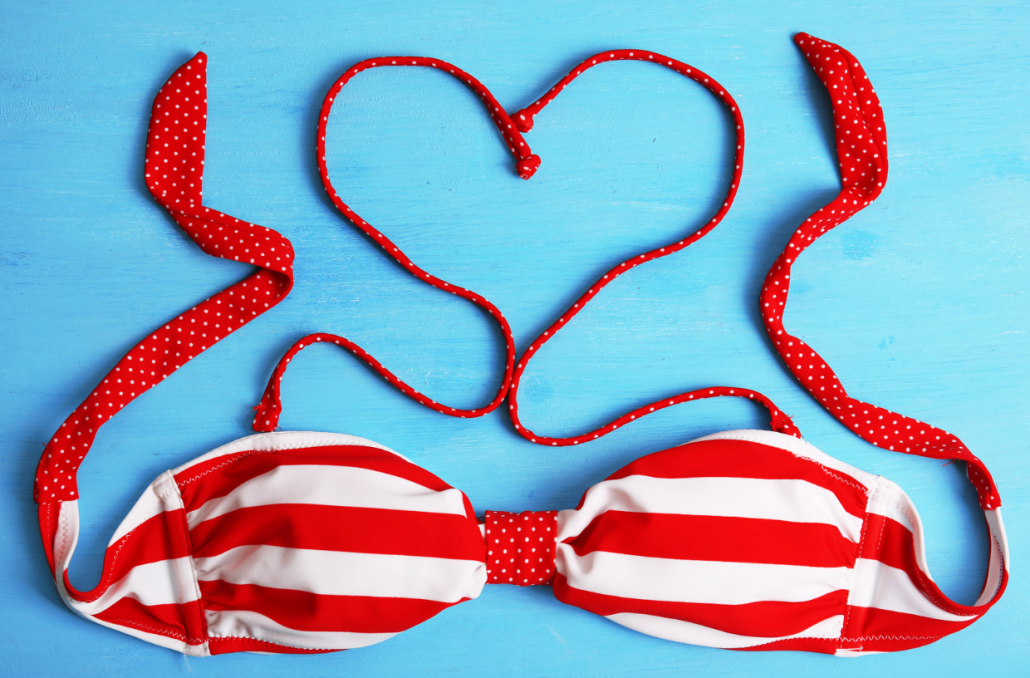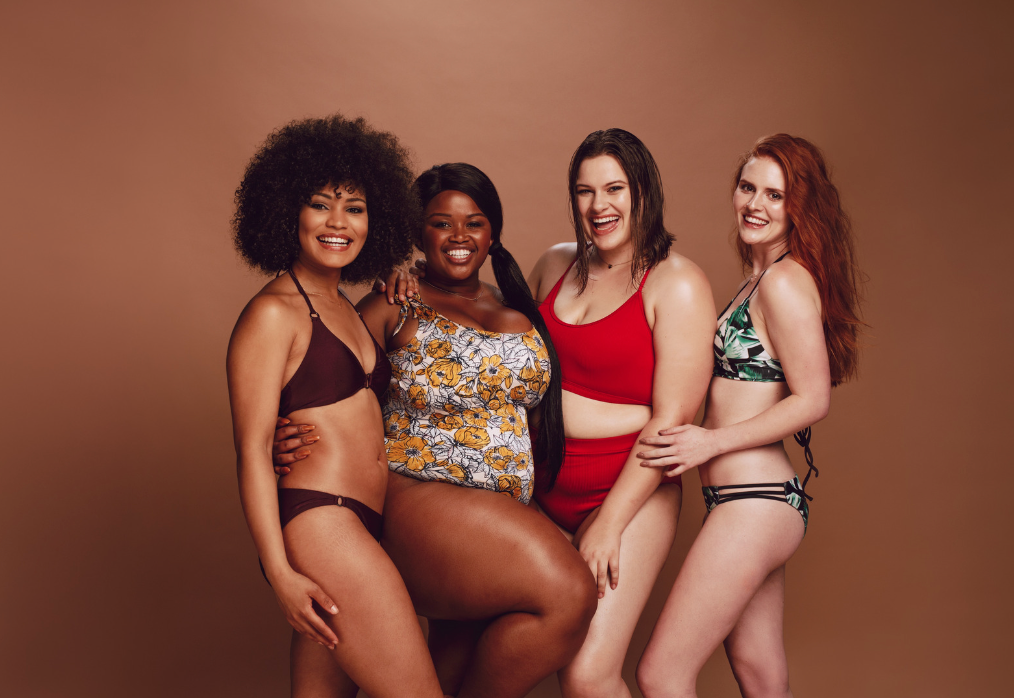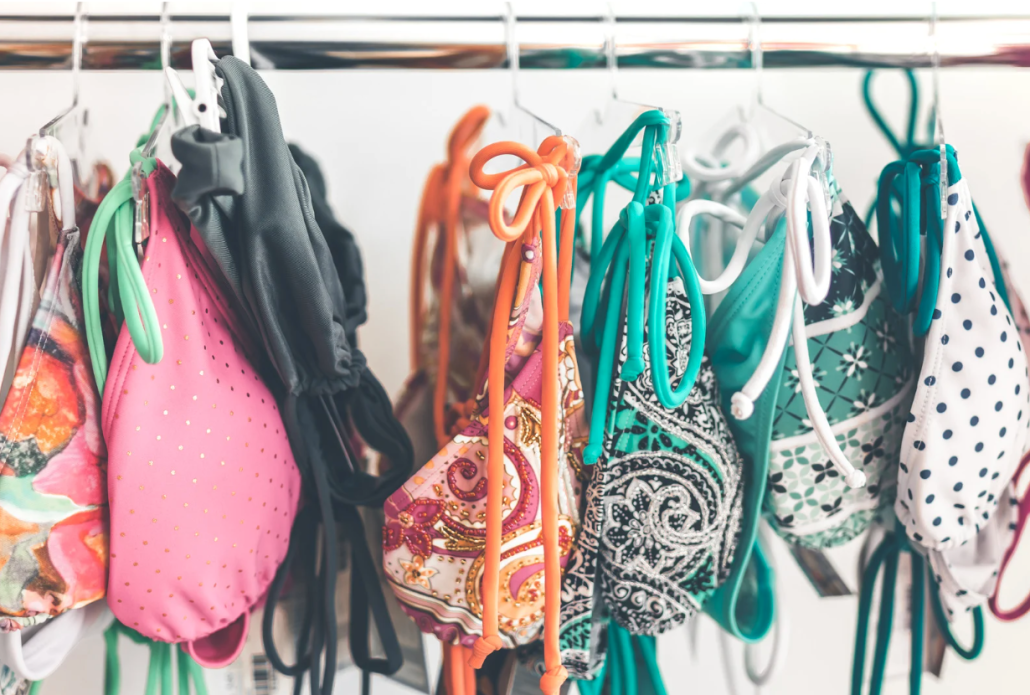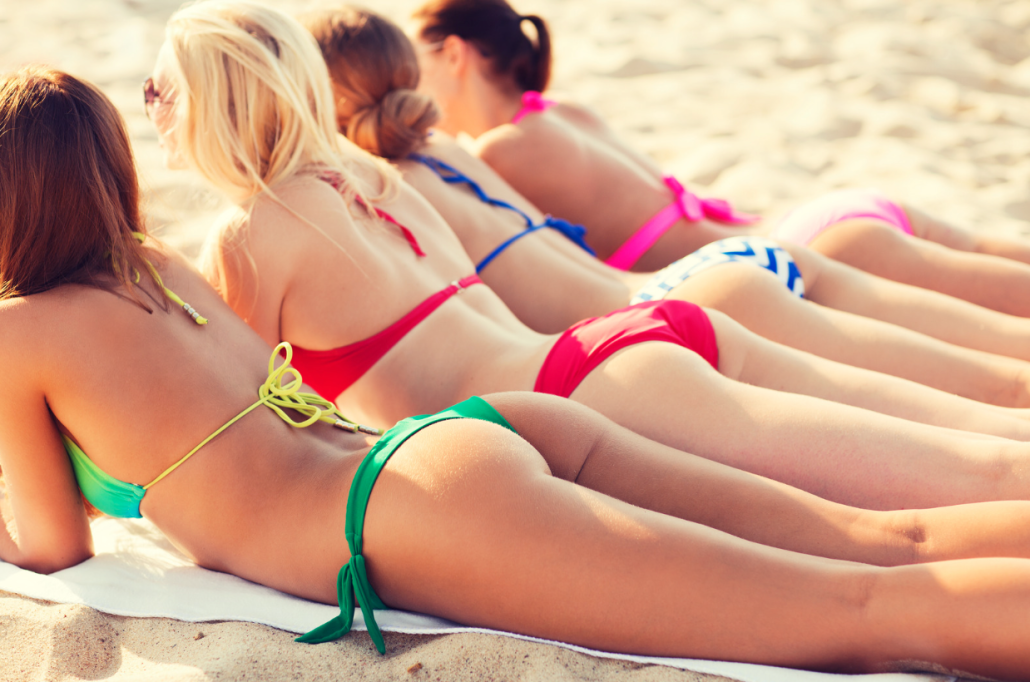Stop and think for a moment where the first bathing suits were seen. Well, it happens to be the ancient Roman Villa Romana del Casale (286-305 AD) in Sicily and it contains one of the earliest known illustrations of a bikini. And then, fast forward through the 18th century to the modern bikini that was popularized by Louis Reard, a French engineer. Additionally, in 1946, Jacques Heim, the French fashion designer, along with Reard, have been credited with this “new” phenomenon in, of course, PARIS. Top movie stars such as Brigitte Bardot and Ursula Andress helped popularize this new style of swimwear but it didn’t catch on in western countries until the mid 1960s.
In our fashion world of today, we no longer call these articles of clothing “bathing suits.” The category is now called swimwear and there is an entire family of different names and silhouettes. These names come under the headline of “swimwear terminology” and I hope to clear up any questions or doubts about “what’s what” in the world of swimwear today. Here is a list of swimwear terminology that should help.
SWIMWEAR IN GENERAL –
ONE-PIECE SWIMSUIT: A piece of woman’s clothing, like a leotard, that covers the torso in one piece and is meant for swimming or sunbathing.
MAILLOT: A woman’s one-piece suit. It is pronounced MY-OH.
MONOKINI: The old school term, “monokini,” meant a one-piece swimsuit that exposed the breasts. Today, it actually refers to a woman’s one-piece swimsuit with cutouts on the sides and/or front. (Also called a Cut-Away Swimsuit)
BIKINI: A woman’s two-piece swimsuit: a top, or a bra and a bottom, or panty.
ONE SHOULDER: A swimsuit that has only one shoulder strap, or support, creating an asymmetrical design.
TANK SUIT: A sleeveless one-piece swimsuit that has straps over the shoulder.
TANKINI: A woman’s two-piece suit that’s somewhere between a bikini and a one-piece swimsuit, with the top part covering the breasts, as well as the ribs.
BRAZILIAN BIKINI: This is the general term for the skimpy, sexy swimsuits that originate from Brazil. They generally have very small cut bottoms, especially in the back.
COMPETITION SWIMSUIT: For women, this is usually a specifically designed one-piece that is worn in competitive swimming, such as the Olympics.
TOPS-
ASYMMETRIC: A bikini top or one-piece that has a strap over one shoulder while the other shoulder is bare.
BANDEAU: A woman’s bikini bra top, or one-piece swimsuit bodice that is a singular swath of cloth across the breasts. It can be twisted, ringed, tied, with or without straps or plain.
(SPLIT) BANDEAU: A bandeau top that is cut in the center front, creating a V-neck shape.
BANDED HALTER TOP: A halter bikini top that has a wide elastic band (usually covered with self fabric) under the bust to give added support.
BANDINI: A two-piece swimsuit that is bare on the shoulders – same as a bandeau top.
BRA TOP: A bikini top that has shoulder straps that go straight over the shoulders and meet with the back strap, similar to a bra.
BUSTIER: An elongated demi-underwire. It pushes up the bust by tightening against the upper midriff and forcing the breasts up, while gently shaping the waist.
CHEVRON: This is an inverted V-shaped pattern that helps to give a slimming effect around the stomach.
COLOR BLOCK: A swimwear pattern of two or more solid colors in “blocks”.
CONSTRUCTED SHELF BRA: This is a hidden part of a one-piece or bikini top that uses molded foam cups and a soft, plush, wide elastic under the bust. The cups can be sewn into the fabric lining or inserted into pockets just for that purpose.
CONTOURED TOP: A swim top that has cup seams that create a rounded cup shape to fit the body like a second skin.
CONTROL TOP: One-piece or tankini swimsuits that incorporate power lining and special construction to make the wearer appear more slender.
COOKIE PADS: Small oval shaped pads that can be inserted into the pockets of swim tops for additional uplift and shape.
CROSS BACK ONE-PIECE: A one-piece with criss-cross back straps.
CUTOUT ONE-PIECE: A one-piece suit that is very open on the sides as if they were “cut out.” Sometimes called a monokini.
EMBELLISHED: All the beads, heat transfers, embroideries or any bells and whistles added to a swimwear piece.
FLOUNCE: A strip of decorative fabric attached by one edge to the swimwear piece.
FULL PIECE BATHING SUIT: Another name for a one-piece swimsuit.
HALTER TOP: A bikini top that has elongated cups that tie around the neck.
STATIONARY HALTER TOP: A halter top that is permanently attached to a bodice strap and cannot slide back and forth.
SLIDING HALTER TOP: A halter top that has a tunnel along the bottom of the cups for a strap to slide through. This allows the top to be adjusted for a better fit.
KEYHOLE: A suit with a round “cut out” of fabric. The keyhole can be at the neckline, it can expose skin between the breasts, or it can be on the stomach or in the back. It can be small or large.
PLUNGING NECKLINE: A tankini or one-piece with a deep V cut exposing the cleavage.
UNDERWIRE TOP: A bikini top or one-piece swimsuit bodice that has supportive, curved wires under the breasts.
DEMI-UNDERWIRE TOP: An underwire top that is cut low on the breast, allowing more of the bosom to show.
FLOATING UNDERWIRE: Similar to a regular underwire, but the wire is suspended within the layers of fabric so it does not show from the outside.
TRI-TOP: A simple bikini top that consists of two triangles and strings around the neck and back.
RASH GUARD: A type of swimwear tightly fit shirt that is often long or short sleeved.
REVERSIBLE: A reversible swimsuit is swimwear that can be worn either way. It usually has a different color or print on the reverse side.
RUCHED: The technique of gathering the fabric to create a puckered or shirred effect. This can be done on the top or a bottom.
SASH: A soft fabric tie at the neck, back or hips to secure the suit on the body.
SCOOP NECK: A swim piece with a deeply curved wide neckline.
SPORT TOP: A bikini top designed with no underwires or padding that may interfere with sports activities. Usually has more coverage.
SWEETHEART TOP: A swimwear top that looks like the top of a heart.
STATIONARY TRI-TOP: A tri-top that is permanently secured to a bodice strap and does not slide back and forth.
ELONGATED TRI-TOP: A tri-top that slides along a bodice strap and the top points of the triangle are elongated to look similar to a halter top.
BOTTOMS –
BOARD SHORTS: Cool and breezy shorts that are perfect for summertime activity. They come in long, standard and short lengths.
BOY SHORTS: These swimsuit bottoms provide full coverage with a lower leg cut.
BRAZILIAN-CUT: A bikini bottom that is cut shapely and skimpy in back showing much of the bum and offering minimal coverage in back.
THONG: Usually a two-piece swimsuit that has very, very little fabric covering the back side of the bum, forming a Y shape in the back.
HIPSTER BOTTOM: A bikini bottom that is like a woman’s set of shorts, but is low on the hips. It offers a little more coverage than the average bikini bottom.
MICROKINI: A very skimpy bikini that keeps the wearer just within legal limits of deceny but not quite nude.
MODERATE BOTTOM: A bikini bottom, not too much coverage and not too little.
SKIRTED BOTTOM/SWIM SKIRT: A bikini bottom with an attached skirt.
SPAGHETTI: Thin fabric strings used for swimwear.
STRING BOTTOM: A bikini bottom that has strings at the hips that may tie, or may be stationary.
TIE-SIDE BOTTOM: A bikini bottom that has strings at the hips that tie.
EURO-CUT BOTTOM: A moderate back coverage bikini bottom that is cut with straight, triangular lines in back. It’s skimpier than an American Cut, but not quite as trim, or curvy as a Brazilian Cut and offering somewhere between minimal and moderate coverage in back.
SCRUNCHY BOTTOM: A bikini bottom that has a gathered, center seam in the back, creating more shapely cheeks.
SCUBA BOTTOM: A low-rise bikini with a self belt. Also called a surf bottom.
AMERICAN-CUT: A bikini bottom that is cut shapely and slightly fuller in back than a Euro-Cut or Brazilian-Cut. In the 60s, this was a full cut in back, but now it is much trimmer, offering moderate coverage.
BY: CAMILLE BLOCK – FASHION INSTITUTE OF TECHNOLOGY






